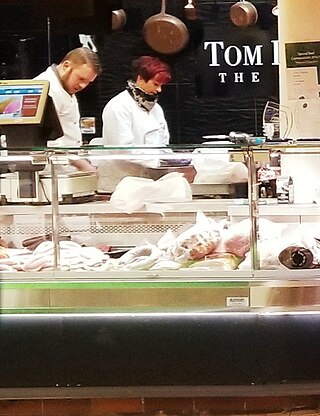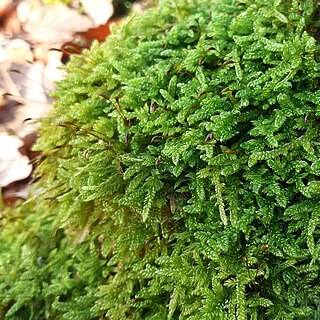
Pollution is the introduction of contaminants into the natural environment that cause adverse change. Pollution can take the form of any substance or energy. Pollutants, the components of pollution, can be either foreign substances/energies or naturally occurring contaminants.

Urban areas usually experience the urban heat island (UHI) effect, that is, they are significantly warmer than surrounding rural areas. The temperature difference is usually larger at night than during the day, and is most apparent when winds are weak, under block conditions, noticeably during the summer and winter. The main cause of the UHI effect is from the modification of land surfaces while waste heat generated by energy usage is a secondary contributor. A study has shown that heat islands can be affected by proximity to different types of land cover, so that proximity to barren land causes urban land to become hotter and proximity to vegetation makes it cooler. As a population center grows, it tends to expand its area and increase its average temperature. The term heat island is also used; the term can be used to refer to any area that is relatively hotter than the surrounding, but generally refers to human-disturbed areas. Urban areas occupy about 0.5% of the Earth's land surface but host more than half of the world's population.

Stormwater, also written storm water, is water that originates from precipitation (storm), including heavy rain and meltwater from hail and snow. Stormwater can soak into the soil (infiltrate) and become groundwater, be stored on depressed land surface in ponds and puddles, evaporate back into the atmosphere, or contribute to surface runoff. Most runoff is conveyed directly as surface water to nearby streams, rivers or other large water bodies without treatment.

Water pollution is the contamination of water bodies, with a negative impact on their uses. It is usually a result of human activities. Water bodies include lakes, rivers, oceans, aquifers, reservoirs and groundwater. Water pollution results when contaminants mix with these water bodies. Contaminants can come from one of four main sources. These are sewage discharges, industrial activities, agricultural activities, and urban runoff including stormwater. Water pollution may affect either surface water or groundwater. This form of pollution can lead to many problems. One is the degradation of aquatic ecosystems. Another is spreading water-borne diseases when people use polluted water for drinking or irrigation. Water pollution also reduces the ecosystem services such as drinking water provided by the water resource.

A leaf blower, commonly known as a blower, is a device that propels air out of a nozzle to move debris such as leaves and grass cuttings. Leaf blowers are powered by electric or gasoline motors. Gasoline models have traditionally been two-stroke engines, but four-stroke engines were recently introduced to partially address air pollution concerns. Leaf blowers are typically self-contained handheld units, or backpack mounted units with a handheld wand. The latter is more ergonomic for prolonged use. Larger units may rest on wheels and even use a motor for propulsion. These are sometimes called "walk-behind leaf blowers" because they must be pushed by hand to be operated. Some units called blower vacs, can also suck in leaves and small twigs via a vacuum, and shred them into a bag.

Urban forestry is the care and management of single trees and tree populations in urban settings for the purpose of improving the urban environment. Urban forestry involves both planning and management, including the programming of care and maintenance operations of the urban forest. Urban forestry advocates the role of trees as a critical part of the urban infrastructure. Urban foresters plant and maintain trees, support appropriate tree and forest preservation, conduct research and promote the many benefits trees provide. Urban forestry is practiced by municipal and commercial arborists, municipal and utility foresters, environmental policymakers, city planners, consultants, educators, researchers and community activists.

Drisheen is a type of blood pudding made in Ireland. It is distinguished from other forms of Irish black pudding by having a gelatinous consistency. It is made from a mixture of cow's, pig's or sheep's blood, milk, salt and fat, which is boiled and sieved and finally cooked using the main intestine of an animal as the sausage skin. The sausage may be flavoured with herbs. Historically, tansy had sometimes been used as a seasoning for drisheen. However, it has since been discovered to be toxic to humans. The recipe for drisheen varies widely from place to place and it also differs depending on the time of year. Drisheen is a cooked product but it usually requires further preparation before eating. How this is done varies widely from place to place.

Environmental issues in Afghanistan are monitored by the National Environmental Protection Agency (NEPA). They predate the political turmoil of the past few decades. Forests have been depleted by centuries of grazing and farming, practices which have only increased with modern population growth.

An urban forest is a forest, or a collection of trees, that grow within a city, town or a suburb. In a wider sense, it may include any kind of woody plant vegetation growing in and around human settlements. As opposed to a forest park, whose ecosystems are also inherited from wilderness leftovers, urban forests often lack amenities like public bathrooms, paved paths, or sometimes clear borders which are distinct features of parks. Care and management of urban forests is called urban forestry. Urban forests can be privately and publicly owned. Some municipal forests may be located outside of the town or city to which they belong.

Air pollution is the contamination of air due to the presence of substances called pollutants in the atmosphere that are harmful to the health of humans and other living beings, or cause damage to the climate or to materials. It is also the contamination of the indoor or outdoor environment either by chemical, physical, or biological agents that alters the natural features of the atmosphere. There are many different types of air pollutants, such as gases, particulates, and biological molecules. Air pollution can cause diseases, allergies, and even death to humans; it can also cause harm to other living organisms such as animals and crops, and may damage the natural environment or built environment. Air pollution can be caused by both human activities and natural phenomena.
Environmental policy in China is set by the National People's Congress and managed by the Ministry of Environmental Protection of the People's Republic of China. Under the Ministry of Environmental Protection of the People's Republic of China, the Department of Policies, Laws, and Regulations is in charge of establishing and strengthening basic laws and policies such as environmental laws, administrative policies and economical regulations. It is also responsible for the development of national environmental protection policy and macro strategy.

Urban runoff is surface runoff of rainwater, landscape irrigation, and car washing created by urbanization. Impervious surfaces are constructed during land development. During rain, storms, and other precipitation events, these surfaces, along with rooftops, carry polluted stormwater to storm drains, instead of allowing the water to percolate through soil. This causes lowering of the water table and flooding since the amount of water that remains on the surface is greater. Most municipal storm sewer systems discharge untreated stormwater to streams, rivers, and bays. This excess water can also make its way into people's properties through basement backups and seepage through building wall and floors.

Water pollution in the United States is a growing problem that became critical in the 19th century with the development of mechanized agriculture, mining, and industry, although laws and regulations introduced in the late 20th century have improved water quality in many water bodies. Extensive industrialization and rapid urban growth exacerbated water pollution as a lack of regulation allowed for discharges of sewage, toxic chemicals, nutrients and other pollutants into surface water.
The health of a mother directly affects the fetus during pregnancy. High levels of vehicle pollution where pregnant women reside can have adverse health effects on fetuses.
Pristina, the capital of the Republic of Kosovo, is the country's most populated city with more than 200,000 inhabitants. Its air pollution level rivals big cities like Beijing, Mumbai and New Delhi. The main sources of Pristina's air pollution include power plants emissions during energy production, household emissions as well as its traffic.

Smog towers or smog free towers are structures designed as large-scale air purifiers to reduce air pollution particles (smog). This approach to the problem of urban air pollution involves air filtration, and removal of suspended mechanical particulates such as soot, and requires energy or power. Another approach is to remove urban air pollution by a chimney effect in a tall stack, or updraft tower, which may be either filtered or simply released at altitude as with a solar updraft tower, and which may not require operating energy beyond what may be produced by the updraft.
Environmental issues in North Macedonia include air and water pollution, deforestation, threats to endemic species and climate change. There is substantial degree of pollution in the air, water and land of North Macedonia. According to 2019 estimates, the country is considered to have one of the highest degrees of pollution in Europe.

Air pollution in South Korea is an increasing threat to people and the environment. The air pollution comes from many sources, both domestic and international. Many forms of pollution have increased in South Korea since its rapid industrialization, especially in Seoul and other cities. According to the U.S. National Aeronautics and Space Administration (NASA), Seoul is amongst one of the world's cities with the worst air pollution. From 2009 and 2013, the city's mean PM10 were higher than in many of the largest metropolitan cities in the world such as: Los Angeles, Tokyo, Paris, and London. This has resulted in health and environmental problems. Koreans buy masks and air purifiers to breathe cleaner air, and are working to reduce the country's emissions.

Hypnum is a genus of mosses belonging to the family Hypnaceae.
Pollution in Korea has become diversified and serious due to rapid industrialization and urbanization since the 1960s. The causes of environmental pollution, both in South and North Korea, can be found in population growth, urban concentration, and industrial structure, similar to the rest of the world.

















